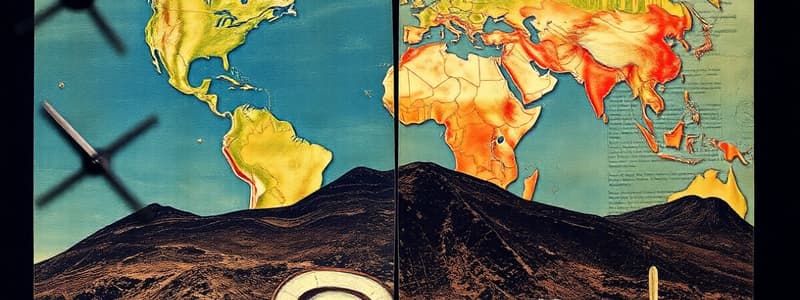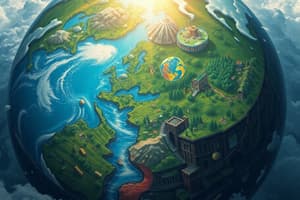Podcast
Questions and Answers
Match the following terms with their definitions:
Match the following terms with their definitions:
Lithosphere = Water held in the solid outer layer of the Earth's crust Biosphere = Part of Earth in which life exists, including land, water, and air Cryosphere = Involves ice and its impact on the water cycle P factors = Factors that influence water flow and flooding
Match the following water cycle components with their characteristics:
Match the following water cycle components with their characteristics:
Atmosphere = Accounts for 0.01% of all water on Earth Lithosphere = Accounts for 1.7% of all water on Earth Cryosphere = Grows during periods of cooling Biosphere = Encapsulates all living organisms and their environments
Match the following concepts to their effects on surface runoff:
Match the following concepts to their effects on surface runoff:
P factors - steepness = Steep sides lead to faster overland flow P factors - vegetation = Natural land use increases interception and evapotranspiration Cryospheric change - warming = Melting ice adds water to the water cycle Cryospheric change - cooling = Ice restricts the return of water to the sea
Match the following conditions with their impacts on the water cycle:
Match the following conditions with their impacts on the water cycle:
Match the following percentages with their relevant water sources:
Match the following percentages with their relevant water sources:
Match these terms with their corresponding environmental roles:
Match these terms with their corresponding environmental roles:
Match the following effects of climate change on the cryosphere:
Match the following effects of climate change on the cryosphere:
Match the following impacts of ocean acidification with their effects:
Match the following impacts of ocean acidification with their effects:
Match the following components of the water cycle with their roles:
Match the following components of the water cycle with their roles:
Match the following consequences of shrinking Arctic ice with their outcomes:
Match the following consequences of shrinking Arctic ice with their outcomes:
Match the following aspects of the carbon cycle with their interactions:
Match the following aspects of the carbon cycle with their interactions:
Match the following statements about freshwater availability with their effects:
Match the following statements about freshwater availability with their effects:
Match the following periods with their characteristics:
Match the following periods with their characteristics:
Match the following processes with their definitions:
Match the following processes with their definitions:
Match the following climatic events with their timeframes:
Match the following climatic events with their timeframes:
Match the following climatic phenomena with their effects:
Match the following climatic phenomena with their effects:
Match the following terms with their examples:
Match the following terms with their examples:
Match the following environmental impacts with their sources:
Match the following environmental impacts with their sources:
Match the following periods with the climate types they represent:
Match the following periods with the climate types they represent:
Match the following climatic changes with their consequences:
Match the following climatic changes with their consequences:
Match the following theories or concepts with their descriptions:
Match the following theories or concepts with their descriptions:
Match the following locations with their carbon storage characteristics:
Match the following locations with their carbon storage characteristics:
Match the following elements with their carbon storage forms:
Match the following elements with their carbon storage forms:
Match the following terms with their relevant definitions:
Match the following terms with their relevant definitions:
Match the following processes/parts of the Earth with their characteristics:
Match the following processes/parts of the Earth with their characteristics:
Match the following ecosystems with their carbon dynamics:
Match the following ecosystems with their carbon dynamics:
Match the following terms related to Earth's systems:
Match the following terms related to Earth's systems:
Match the following carbon cycles with their definitions:
Match the following carbon cycles with their definitions:
Match the carbon cycle components with their descriptions:
Match the carbon cycle components with their descriptions:
Match the carbon cycle functions to their locations:
Match the carbon cycle functions to their locations:
Match the processes to their carbon cycle impacts:
Match the processes to their carbon cycle impacts:
Match the sources of carbon with their respective roles:
Match the sources of carbon with their respective roles:
Match the impact of carbon on ecosystems with the respective context:
Match the impact of carbon on ecosystems with the respective context:
Match the carbon cycle regulation aspects to their effects:
Match the carbon cycle regulation aspects to their effects:
Match the natural phenomena with their carbon involvement:
Match the natural phenomena with their carbon involvement:
Match the carbon cycle elements to their ecological roles:
Match the carbon cycle elements to their ecological roles:
Match the effects of human activity on the carbon cycle with the corresponding descriptions:
Match the effects of human activity on the carbon cycle with the corresponding descriptions:
Flashcards
Lithosphere
Lithosphere
The solid outer layer of the Earth, including the crust and upper mantle. It holds 1.7% of Earth's water, storing it for the longest time.
Biosphere
Biosphere
The part of Earth where life exists, including land, water, and air (atmosphere).
Cryosphere
Cryosphere
The frozen parts of Earth, like glaciers, ice sheets, and sea ice.
Cryospheric change
Cryospheric change
Signup and view all the flashcards
P factors: Steepness
P factors: Steepness
Signup and view all the flashcards
P factors: Vegetation
P factors: Vegetation
Signup and view all the flashcards
P factors: Land Use
P factors: Land Use
Signup and view all the flashcards
Weathering
Weathering
Signup and view all the flashcards
Erosion
Erosion
Signup and view all the flashcards
Gaia Hypothesis
Gaia Hypothesis
Signup and view all the flashcards
Ocean acidification
Ocean acidification
Signup and view all the flashcards
Global distribution of carbon
Global distribution of carbon
Signup and view all the flashcards
Coral reefs and coastal communities
Coral reefs and coastal communities
Signup and view all the flashcards
Carbon sink
Carbon sink
Signup and view all the flashcards
Net primary productivity
Net primary productivity
Signup and view all the flashcards
Carbon cycle and ocean acidification
Carbon cycle and ocean acidification
Signup and view all the flashcards
Positive feedback loop in the water cycle
Positive feedback loop in the water cycle
Signup and view all the flashcards
Carbon in the lithosphere
Carbon in the lithosphere
Signup and view all the flashcards
Negative feedback loop in the water cycle
Negative feedback loop in the water cycle
Signup and view all the flashcards
Longest store of carbon
Longest store of carbon
Signup and view all the flashcards
Where is carbon most abundant?
Where is carbon most abundant?
Signup and view all the flashcards
Quaternary Period
Quaternary Period
Signup and view all the flashcards
Holocene
Holocene
Signup and view all the flashcards
Last Glacial Maximum
Last Glacial Maximum
Signup and view all the flashcards
Little Ice Age
Little Ice Age
Signup and view all the flashcards
Anthropecene
Anthropecene
Signup and view all the flashcards
Dendrochronology
Dendrochronology
Signup and view all the flashcards
What are tree rings like in warm and wet years?
What are tree rings like in warm and wet years?
Signup and view all the flashcards
What are tree rings like in cold and dry years?
What are tree rings like in cold and dry years?
Signup and view all the flashcards
What is the impact of soil exploitation?
What is the impact of soil exploitation?
Signup and view all the flashcards
Why were decomposers less effective in the Little Ice Age?
Why were decomposers less effective in the Little Ice Age?
Signup and view all the flashcards
What are fossil fuels?
What are fossil fuels?
Signup and view all the flashcards
Carbon cycle
Carbon cycle
Signup and view all the flashcards
Global carbon budget
Global carbon budget
Signup and view all the flashcards
Terrestrial carbon cycle
Terrestrial carbon cycle
Signup and view all the flashcards
Marine carbon cycle
Marine carbon cycle
Signup and view all the flashcards
Photosynthesis
Photosynthesis
Signup and view all the flashcards
Respiration
Respiration
Signup and view all the flashcards
Decomposition
Decomposition
Signup and view all the flashcards
Combustion
Combustion
Signup and view all the flashcards
Greenhouse effect
Greenhouse effect
Signup and view all the flashcards
Study Notes
Positive and Negative Feedback
- Positive feedback: Effects of an action are amplified by secondary effects
- Negative feedback: Effects of an action are nullified by knock-on effects, returning the system to balance
Major Subsystems
- Hydrosphere, atmosphere, biosphere, lithosphere, and cryosphere
Open and Closed Systems
- Open system: Matter and energy can be transferred from the system to the surrounding environment
- Closed system: Transfers of energy occur into and out of the system but not matter
Dynamic Equilibrium
- The tendency towards a natural state of balance within a constantly changing system
Hydrosphere
- Water on or near Earth's surface
- 97% is oceanic water
- Inputs: Runoff and precipitation
- Outputs: Evaporation
- Climate change can decrease capacity
Cryosphere
- Portions of Earth's surface where water is in solid form
- Accounts for 1.7% of all water on Earth
- Includes ice sheets, ice caps, sea ice, glaciers, and permafrost
- 68% of freshwater is stored in ice caps and glaciers
Lithosphere
- Earth's crust and upper mantle
- Stores water for the longest time
- Accounts for 1.7% of all water on Earth
Atmosphere
- Accounts for 0.01% of all water on Earth
- Most common atmospheric water is water vapor
Biosphere
- Part of the Earth where life exists (land, water, and air)
Cryospheric Change
- In cooling periods, the cryosphere grows.
- In warming periods, ice melts, adding water to the cycle, and increasing sea level rise.
Factors Affecting Water Flow
- Steepness: Faster water flow on steeper slopes
- Vegetation: Natural land use intercepts, takes up water, reduces surface runoff and less flooding, more infiltration, and evapotranspiration.
- Deforestation: Reduced interception, faster runoff, flashy hydrographs, increased soil erosion, higher risk of flooding.
- Urbanization: Impermeable surfaces lead to no infiltration and overland flow, flashy hydrographs, greater risk of flooding.
- Agriculture: More interception and infiltration.
- Afforestation: Increased interception, root uptake, and evapotranspiration, reducing surface runoff and risk of flooding.
Infiltration
- The movement of water from the surface into the soil
- Saturated, baked, or frozen soils are impermeable and have lower infiltration capacities.
- Vegetated areas have high infiltration rates.
Infiltration Rate
- The speed at which soil absorbs water
- Declines rapidly at the start of rainfall, then reaches a constant value.
Infiltration Capacity
- The maximum rate at which soil can absorb water
- If rainfall intensity exceeds infiltration capacity, surface runoff occurs
Evapotranspiration
- The sum of evaporation and plant transpiration from Earth's surface to the atmosphere
Condensation
- The change of state from a gas to a liquid as air cools
Evaporation
- Liquid water changing to water vapor; caused by solar radiation
Drainage Basin
- The area that supplies a river with its water supply. High land separates drainage basins.
Percolation
- Water moving downwards through soil and rock due to gravity, can move laterally to feed rivers
Throughflow
- Water flowing horizontally through the top soil layer
Throughfall
- Rainfall that falls directly to the ground without interception
Interception
- Water prevented from reaching the surface by trees or vegetation. Store of water.
Exmoor Mires Project
- Project for draining ditches on the River Exe.
- Results include increased infiltration capacity, reduced risk of flooding, and improved water quality.
Soil Water Balance
- The balance between inputs and outputs (precipitation, evapotranspiration, storage changes) to the soil.
- Positive balance: Precipitation exceeds evapotranspiration
- Negative balance: Evapotranspiration exceeds precipitation, soil moisture can reach deficit
Baseflow
- Part of a river's discharge supplied by groundwater seeping into the riverbed. Slow process.
Studying That Suits You
Use AI to generate personalized quizzes and flashcards to suit your learning preferences.




